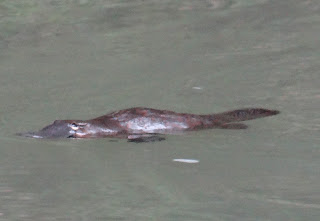 |
| Platypus in Petrie Creek |
The Platypus is enjoying something of a population boom around Queensland’s Sunshine Coast following three years of above-average rainfall. However, the Queensland Government is under pressure to follow the rest of the country by banning a type of yabby trap that is needlessly slaughtering Platypus and other aquatic wildlife, posing a local extinction threat in times ahead.
 |
| Patypus in Petrie Creek |
During drought conditions the monotreme population drops sharply, with survivors sometimes being confined to isolated pools – for instance in Booloumba and Little Yabba creeks - or making hazardous journeys overland in search of better habitat. Right now, however, the animals are being seen locally in watercourses where they’ve long been infrequent or absent;
| Rakali (Water Rat) |
This is likely to be the case elsewhere within the east Australian range of the species. Those Sunshine Coast sites include Petrie Creek in Nambour, a short way down the road from my home, where upwards of eight Platypus have been recorded over a couple of kilometres close to the bustling Central Business District. The animal photographed here is frequently seen right next to a bridge over busy Arundell Avenue. The species has long been known to frequent Petrie Creek but the current frequency of sightings is pretty much unprecedented.
 |
| Petrie Creek |
A Facebook page, Platypus and Echidna Watch Friends Sunshine Coast, is showcasing almost daily photographs and videos of Platypus from Petrie Creek and across many sites on the coast and in the hinterland. The species was found for the first time recently in the South Maroochy River. Also doing well are other aquatic animals including the Water Dragon, various turtles, and the Rakali (Water Rat). The regional Platypus population has stared down threats to its survival in the past. I recall that as a journalist in 2005, I covered protests against plans to construct a Woolworths supermarket adjacent to Platypus habitat in Obi Obi Creek in Maleny. Protesters sobbed and declared that all the Platypus were doomed. Luckily they weren’t. They are often seen in the creek below the supermarket these days and Maleny is one of the region’s top Platypus-watching hotspots.
 |
| Yabby Opera House Trap advertised online |
Nonetheless, Platypus and other aquatic wildlife face a grave threat in the form of the so-called Yabby Opera House Trap, which traps and kills the animals. Enticed by captured yabbies, a favoured food item, they enter the trap and cannot escape, drowning in a few minutes. More environmentally friendly alternative traps are available.
 |
| Seven platypus found dead in yabby trap in Victoria's Werribee River |
Maleny wildlife enthusiast Neil Andison recently wrote to the Queensland Premier and government MPs, pointing out that the traps have been banned in other states and the ACT. However, they remain easily accessible online, where no warnings are displayed about their impact or the ban in most states. A single trap has been known to kill as many as eight Platypus.
 |
| One of five platypus drowned in a yabby trap |
When dry conditions inevitably return, and Platypus numbers again plummet, the traps will pose a threat to the survival of regional populations.
 |
| A pair of platypus drowned in the Gold Coast hinterland. |
In his letter, Neil refers to Queensland’s “disgraceful” refusal to ban the traps, which are responsible for the “needless death of all manner of air-breathing creatures that call our creeks and rivers home”.
 |
| Two rikalis (water rats) drowned in a Queensland trap |
The Platypus is regarded as one of the most remarkable mammals in the world. We can do better.
 |
| Platypus at Amamoor, Sunshine Coast hinterland |